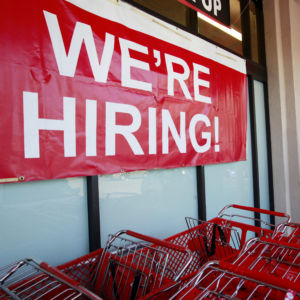The labor market continued trending in a positive direction by gaining an additional 227,000 new jobs for the month of January, according to a federal report Friday.
The economy has made significant gains over the last year following nearly a decade of slow growth. The last recession was followed by an unusually slow recovery. The Bureau of Labor Statistics (BLS) found in its latest monthly jobs report the upward trend continued with 227,000 new jobs.
“Total nonfarm payroll employment increased by 227,000 in January, and the unemployment rate was little changed at 4.8 percent,” the report stated. “Job gains occurred in retail trade, construction, and financial activities.”
The economy has been in a good position when in comes to the employment rate. It has even managed to reach close to full employment at 4.8 percent. The economy still faces some lingering issues from the recession, but overall things are at least looking optimistic.
“The labor market looks to be pretty strong,” Florida State University Professor Randall Holcombe told InsideSources. “The unemployment rate is holding pretty steady, under five percent. We’re adding those jobs with the unemployment rate staying steady. What that seems to suggest is more people are participating in the labor force.”
Republicans in the last election were able to gain the presidency while keeping congressional control. They have put forth a very pro-business agenda which could yield positive results. Center for American Progress economist Michael Madowitz agrees the labor market is in good shape, but is concerned the political shift could create uncertainty.
“Increased uncertainty tends not to be ideal for the economy,” Madowitz told InsideSources. “The party in power has a fairly long and ambitious agenda, and there’s invariably going to be a lot of uncertainty associated with that because you just don’t know how much they’re going to be able to pass.”
The economy has been trending in a positive direction but there is still room for improvement. The labor force participation rate, for instance, has fallen considerably since the last recession, and has failed to rebound. The participation rate increased by 0.2 percent last month, and now sits at 62.9 percent
“It was a pretty steady decline in the labor force participation rate from 2007 up through 2015,” Holcombe said. “To me, the labor force participation rate has been one of the more troubling things in the labor market over the last decade or so.”
The labor participation rate tracks the number of employed and those actively seeking work as a percentage of the total population. The participation rate factors in those who have suffered long-term joblessness. Holcombe is optimistic in that the decline leveled out last year, and has remained steady.
“It’s conceivable with the unemployment rate holding steady, with strong job performance, maybe that’s an indication that people out of the labor force are getting back in,” Holcombe said. “So just from where I’m looking at, I’m seeing some optimistic signs in the labor market.”
The participation rate has leveled out but has yet to regain what it lost over the last decade. A large population of retirees and student adults can be blamed for much of the decline. Nevertheless, there are still a concerning number of working age adults that are not in the labor force.
“The low labor force participation rate truly, we believe, is a disconnect and indicates a disconnect between the general unemployment rate, and true unemployment rate,” Job Creators Network President Alfredo Ortiz told InsideSources. “When you look at the labor force participation rate between prime age workers, that 24 to 54 year old, that’s near a generational low.”
The last recession was sparked by the subprime mortgage crisis and the financial crisis of 2007. Former President Barack Obama oversaw the recovery throughout his entire administration. President Donald Trump now faces the issues still lingering like the participation rate, underemployment, and low wages.
“One thing that President Trump has talked about is deregulation,” Holcombe said. “Regulations hold back business; add costs to business. Deregulation is one thing that we can hope for. We can hope for tax reform. That’s another thing that President Trump has talked about that would be helpful.”
Trump released a detailed tax plan during his campaign aimed at promoting economic growth. It’s designed to simplify the tax code while also lowering taxes for upper and middle-income earners. Alfredo notes that lower taxes will be very beneficial, especially for small businesses.
“There’s a lot of conversations about comprehensive tax reform,” Ortiz said. “When you relieve that small business tax on small business owners, you will see hiring like you’ve never seen before. The one thing we know about small businesses is they reinvest their dollars back into businesses whether its direct hires or whether it’s through direct investments like buying another new piece of equipment.”
The Gross Domestic Product (GDP) last year showed a positive increase after being stuck around one percent. GDP tracks the total dollar value of all goods and services produced over a specific time period. The stock market has shown positive growth as well.
Retail trade saw the most significant increase of new jobs at 46,000 followed by construction and financial activities. Mining and logging, manufacturing, wholesale trade, transportation, and warehousing, information, and government showed little change last month.
Average wages increased by 3 cents and now sit at $26.00 for the month of January. Wages in recent months have shown slow but positive growth. The jobs report does not include farm workers, private household employees or nonprofits.

